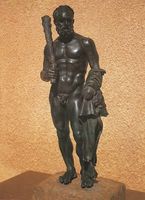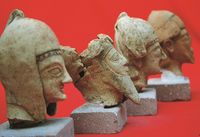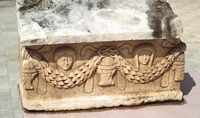Alanya Archaeological Museum includes bronze, marble, ceramics, glass artefacts, mosaics, works of art, traditional belongings, guns, handicrafts, pots, pans and a replica of an old Alanya room. The garden is dotted with interesting items, including a corner dedicated to olive oil production in the Roman period.
Some of the most significant exhibits in the museum
- The oldest archaeological find from the Alanya region in the museum is an inscription in the Phoenician language, dating back to 625 B.C.
- Prehistoric and antique bronze, marble, ceramics, glass artefacts and mosaics dating back to the Lydian, Phrygian, Roman and Byzantine periods.
- An epitaph in the Karaman language.
- A large collection of Archaic (700-500 B.C.) coins.
- A bronze sculpture of Herakles from 200 B.C., which has become a popular symbol of the museum.
- Turkish Islamic works of art and traditional belongings, guns, handicrafts, pots and pans from the Alanya area.
- Ethnographic artefacts from the Seljuk and Ottoman eras.
- A replica of an old Alanya room.
The garden
- The garden contains Bronze Age, Urartian, Lydian, Phrygian, Hellenistic and Roman artefacts.
- One corner is dedicated to Roman artefacts related to the production of olive oil.
- There is a large variety of plant and animal species.
Key Facts
- Location: in Damlataş; about 25 minutes’ walk from Alanya Cruise Port and about 10 minutes’ walk from Damlataş Cave.
- Admission: a charge is made for entry to the exhibition halls.
Shorex: combines well with 1, 3, 4, 6 and all excursions to the west of Alanya.





